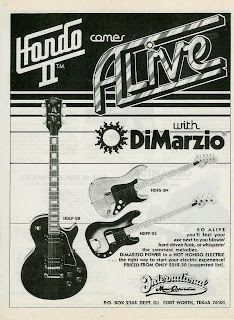HONDO DO NOT MAKE GUITARS
The name Hondo was applied to guitars imported from eastern countries such as Japan, Korea and possibly even Indonesia by a company called International Music Corporation (IMC). Factories made guitars with blank headstocks and importers would apply their own logo. Companies including Antoria and Ibanez had almost identical Les Pauls to Hondo in the early 70s, for example.
What Hondo did do in the 80s was enter into a partnership with the Korean manufacturer Samick and all Hondo branded guitars were made in Korea after this time with the possible exception of a few extremely budget instruments seemingly being made in Indonesia. There are suppositions that Hondo worked with engineers from legendary Japanese manufacturer Tokai to get the Korean operation up to standard, though I have not been able to substantiate this. Tokai did make Fender copies for Hondo in the late 70s so their involvement is possible.
Please beware when reading listing on internet auction sites. They are often wrong and make assumptions about Hondo guitars because the name sounds like the Japanese motor company "Honda" and they have read somewhere that Hondo had an association with Matsumoku and Tokai (in actual fact, guitars were made in these factories for only a relatively short time).
The greatest reply I had from a seller I was interested in purchasing from was that thanks to the stigma surrounding Japanese made products following World War 2, Hondo and other companies would write Korea on their Japanese made instruments so buyers, particularly in the US, would not be put off.
NOT ALL HONDO GUITARS WERE MADE IN JAPAN
Contrary to listing on internet auction sites, a lot of later Hondo guitars were made in Korea. If the country of origin of your guitar matters to you, you best read on! Below is a rough outline of where Hondo guitars were made and when.
60s: Japan
Hondos made at this time tended to look like the model to the left: loosely based on the hugely popular Fender Stratocaster but ultimately crudely made by Fender standards. Nonetheless, these early Japanese guitars are often considered quite collectible.
Early 70s: Japan
In the early 70s, Japanese guitar manufacturing took a small step forward and Hondo wanted to underline this by rebranding as "Hondo II". Bodies were often made of plywood, necks were always bolted on rather than set like their American counterparts but they began to at least look the part.
Identical guitars can be found with names such as Antoria and Ibanez on the headstocks - other importers deciding to add their own name to these mass-produced instruments.
At this time, Hondo tried to differentiate themselves from these other importers by partnering with DiMarzio, the first company to offer off-the-shelf replacement pickups. The standard pickups on these guitars were often very poor, the humbuckers in particular being single coils housed inside a humbucker casing. Hondo became an OEM for DiMarzio in a deal not dissimilar to modern gutiars with "Duncan Designed" pickups today, and offered them as an option for many Hondo models to help improve the sound with reasonable success.
Models with DiMarzio pickups would have a modified code. For example, a HLP (Hondo Les Paul style) would become a HDLP if it had DiMarzio pickups installed.
1979-81 (approx.): Matsumoku and Tokai, Japan
In the late 1970s, Japanese guitar production took a massive step forward. This culminated in the so-called "lawsuit" era when certain Japanese instruments were said to be of such a high quality that they rivalled their American counterparts to a point where the Japanese companies were hit with cease and desist letters. (Long story but the lawsuit didn't actually happen, it basically just threatened the Japanese companies if they continued to make guitars with Fender or Gibson shaped headstocks).
The Matsumoku factory handled Gibson style models (and also an S.D. Curlee licensed model) while the Fender style copies were made by Tokai. All these Japanese guitars were part of the Hondo Professional Series, denoted on the headstock of each. The Fender copies had "Made in Japan" printed on the headstocks while the Matsumoku guitars would have a black and gold "Made in Japan" sticker somewhere on the rear either at the heel of the neck or near the tuners. Some of these guitars had DiMarzio pickups but by no means all of them.
The Professional series first appeared in around 1979 and was last advertised in the 1981/82 cataolgue when the range was expanded to include guitars based on the Danelectro Longhorn and some Musicman examples. It has been said that providing such high quality guitars nearly bankrupted IMC and made cause for a re-think.
1982 onwards: all guitars made in Korea
It is said that Hondo partnered with Samick in Korea to create all of their instruments after this time. Some guitars were aimed at beginners, while the Deluxe Series seemed to aim to build on the success of the Professional Series, presumably while lowering manufacturing costs. There is little evidence of DiMarzio pickups being used after 1982, although Grover tuners were not uncommon as stock.
Hondo also added sub-brands such as Revival, Fame, All-Star and Mastercaster. Each of these had a slightly different aesthetic. It is not unfair to say that Hondo did their absolute best to provide interesting and unusual instruments that would be different from their competitors. Lots of unique colour combinations and hardware options were always prominent throughout the Hondo ranges right through into the 90s.
This looks a lot later than the majority of Hondos I've seen and certainly looks like a resurgence of the HondoII logo not used since the late 70s. I say this because this guitar looks like it was made in the 90s to me, the carefully shaped plastic truss-rod cover looking much newer than those on the 70s Hondo Strats. Who knows?!













